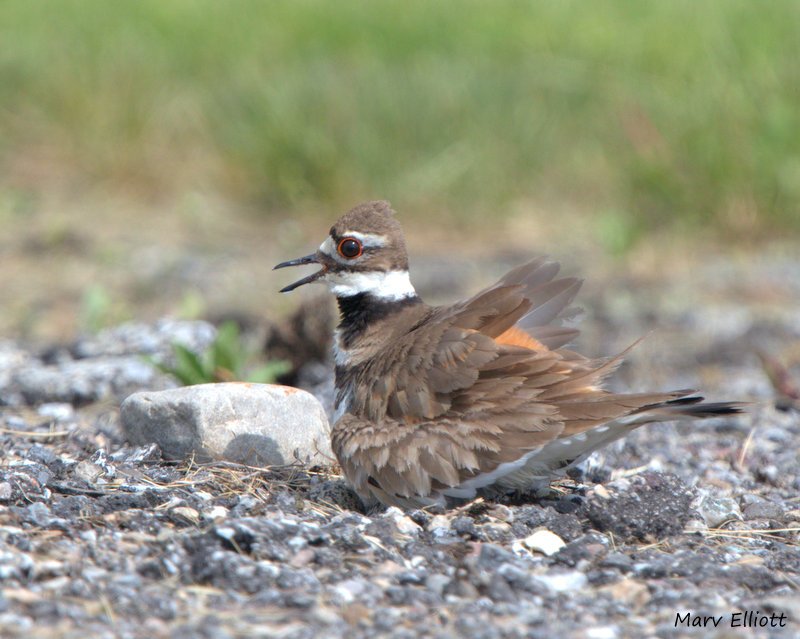Bingo! 100 on the nose for today’s RCAS annual Century Count, our annual attempt to tally 100 species in the county.

As the group gathered at the West Rutland Price Chopper parking lot a Belted Kingfisher flew over, an unusual site for that location, but a good omen for the day. A brief stop at West Rutland Marsh yielded the usual suspects – Willow and Alder flycatcher, Yellow Warbler and Swamp Sparrow. A Wild Turkey was taking an early morning stroll down the road.
The Pleasant Street power line is always pleasant in the early morning. Prairie Warblers, Eastern Towhees and Field Sparrows were heard immediately. “Bees buzz” alerted us to the presence of a winged warbler which turned out to be the real deal, a Blue-winged Warbler, suitably attired for its species. A Prairie Warbler was seen carrying nesting material to an undisclosed location. A Magnolia Warbler was heard in the adjacent woods.
 Then it was back to the marsh for the real treat of the morning – the fledgling Northern Saw-whet Owls. Three were spotted in the trees and brush near the nest box. Who would have thought that Least Bittern and Virginia Rail, both also heard, would be eclipsed by owls at the marsh?
Then it was back to the marsh for the real treat of the morning – the fledgling Northern Saw-whet Owls. Three were spotted in the trees and brush near the nest box. Who would have thought that Least Bittern and Virginia Rail, both also heard, would be eclipsed by owls at the marsh?
Whipple Hollow Road, on the opposite side of the marsh, produced many of the same warbler species observed on last week’s marsh walk: Ovenbird, Northern Waterthrush, Black-and-white Warbler, Nashville Warbler, Northern Parula, Chestnut-sided Warbler and Canada Warbler.
Next it was on the take on the ticks at the Route 4 rest area. Eastern Wood-Pewee was heard for the first time for the day. Two Wood Thrushes gave a lovely concert despite the traffic noise from Route 4 below. Then finally we found our target – the Cerulean Warbler! At the same area both the Cerulean and a Blackburnian Warbler were singing, reminding us that it is impossible to discern a Cerulean by song alone. Finally, after much neck-breaking searching, we spotted a male Cerulean quite high (of course!) in the trees. It appeared to be hawking insects and, at one point, sat on a branch quivering its wings, leading us to believe a female was nearby.
Along the nature trail at Castleton University we picked up Pine Warbler and Louisiana Waterthrush. While sitting in traffic waiting for the marching bands from the Castleton parade to clear, we added Chimney Swift and Carolina Wren.
Our lunch stop at Bomoseen State Park was a welcome respite from the heat. While there we heard Yellow-throated Vireo and Blue-gray Gnatcatcher. An American Redstart was building nest and a Scarlet Tanager was spotted.
 KilldeerBobolinks were found at the Fair Haven Airport and two very hot Killdeer were sitting tight on their nests to keep their eggs cool.
KilldeerBobolinks were found at the Fair Haven Airport and two very hot Killdeer were sitting tight on their nests to keep their eggs cool.
It is becoming difficult to see anything on the conserved land along Route 73 in Brandon/Sudbury as the willows and other vegetation has grown up. However, six Great Blue Herons were seen in flight, along with two Wood Duck. There was a lot of rattling of Marsh Wrens. A Common Gallinule was also heard.
The day ended with a stop at Wildcat Road and Lefferts Pond in Chittenden, where we picked up Winter Wren, Brown Creeper, Black-throated Blue Warbler and Yellow-rumped Warbler. A Broad-winged Hawk was seen perched in the dark woods. And the final bird of the day: a Common Loon floating serenely on Chittenden Reservoir.
Every Century Count has a species that is inexplicably missed. This year there were three: Hermit Thrush, Black-throated Green Warbler and House Finch (a Purple Finch/House Finch was seen, but its true identity was never determined).
Once again, thanks to Roy Pilcher, for planning the trip and the 12 participants who used their sharp eyes and ears to good advantage.
The day's list (27 eBird checklists were entered for the day):